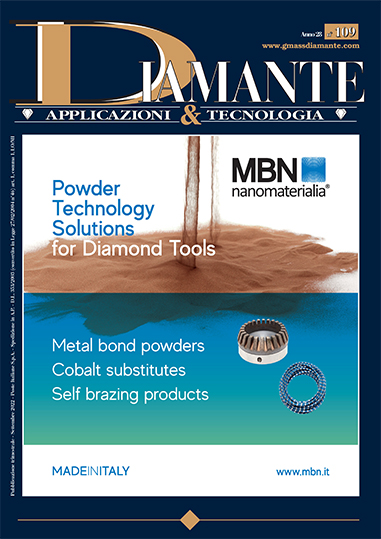|
Diamante A&T Contents Year XXVIII - September 2022 |
|||||
|
Front Cover: MBN NANOMATERIALIA S.p.A. MBN Nanomaterialia offer to the market innovative materials for several applications in powder metallurgy, surface technologies and laser deposition sectors.
In the Spotlight 10) MBN Nanomaterialia: tailored and eco-friendly metal bond powders for diamond tools 20) Hyperion Materials & Technologies acquires Premium Diamond Solutions SA 22) 33.BI-MU, Xylexpo and Viscom Italia together to create new business opportunities Diamond Tools 25) Saw grit diamond sizes, linearization & effects on stone cutting by J. D. Dwan, Trinity College DublinThe University of Dublin, Ireland
Abstract: Diamond saw grit products are sorted according to different parameters. One main parameter
is sieve sorting whereby the diamond crystals are divided according to their size. This is done by sorting the diamond crystals using sieves which go
from a coarse size down to finer sizes. The normal sieving method uses the US Mesh sieve sizes to produce diamond saw grit of different sizes for the
diamond tool maker. However, the size of these diamond grits do not follow a normal linear size when going from one US Mesh size to the next.
The differences in diamond micron size going from one sieve size to the next is not constant when sorting wide ranging sizes of diamond.
The relationship between US Mesh and actual diamond size measured in microns results in an exponential curve when plotted. This paper explores the
influence of this method of sieve sorting of saw diamond and the often unknown challenges it causes the diamond tool maker when designing diamond tools.
A new method is proposed which gives a more linear relationship between diamond sizes when going from a coarse diamond grit to the next size down to
finer sizes. 30) Graphite from industrial waste streams by S. Leinonen1, T. Al-Ani21 Geological Survey of Finland, Kuopio, Finland 2 Geological Survey of Finland, Espoo, Finland
Abstract: Recycling of minerals faces generally quality deviations, also logistical challenges
when there are available only small loads from several destinations. Spent refractories are widely identified as a re-usable material of low-cost uses
(open loop recycling), having also rising interest if the qualities are adequate to substitute virgin materials of high-value products
(closed-loop principle). MgO-C products contain mostly electro-fused and sintered periclase (MgO), but the waste is also a potential resource of flake
graphite. In this study, proper characterization of a magnesia-graphite refractory sample from SSAB Raahesteel factory has been approached by x-ray
diffraction combined with Scanning Electron Microscope (SEM) and chemical analyses. The quantitative phase analysis of the spent MgO-Cshowed 82 wt.% MgO,
12 wt.% carbon (mostlygraphite)and about 5 wt.% calcium-aluminum-silicate phases. Supply of used refractories is quite reliable because the rotation
from primary products to waste is relatively fast, consumption around 10 kg per ton of steel. 38) Influence of cryogenic treatments on metal bonds for diamond tools by M. Franco, E. Carlet, D. Zandonella NeccaADI Srl, Thiene, Italy
Abstract: The aim of this study was to evaluate the effects of cryogenic treatments on diamond tools used in the grinding of hard materials
such as natural and engineered stones. Cryogenic treatments are carried out at extremely low temperatures using cryogenic gases obtained by fractional
distillation of air as heat carriers. The cryogenic cycles applied in the study are those involving the most extreme process temperatures (-160░C to -196░C)
conventionally referred to the Deep Cryogenic Treatment (DCT) category. In two separate test campaigns, finished tools, sintered diamond and without diamond
segments and diamond particles were treated with a cryogenic cycle in liquid nitrogen at boiling temperature followed by a specific post-treatment.
The treated specimens were compared with identical specimens under initial conventional conditions. 55) Correlation between diamond tools functional behaviour and their metal bonds characteristic by M. Franco1, E. Carlet1, D. Zandonella Necca1, A. Zambello2, F. Bonollo21 ADI Srl, Thiene, Italy 2 UniversitÓ di Padova, Vicenza, Italy
Abstract: Many long tests during the working process of diamond tools are required to optimize
their performance. At the same time these tools run under a lot of variables which are difficult to be optimized in the industrial environment
which requires few and short tests. Considering metallic bond diamond tools we necessarily need to consider at least these variables: type, grit
size and concentration of diamond powders, metallic bond, pression, time and temperature of the sintering process, presence or absence of controlled
atmosphere. The Design of Experiment may help to identify the best gradient for the needed modifications. The hipotetical correlation between
characteristic parameters of the sintered material and its performance in the working field would help so much in reaching a fast and reliable way
to optimize the diamond tool. This project focused the attention on measurable parameters such as hardness, tensile strenght, resilience and tried
to find a useful relation with the tool's functional behaviour. Extensive analysis revealed that there isn't any direct correlation between the
measurable parameters and the final performance of the tool, but such parameters can be useful for a local optimization within small
intervals. 60) Performance improvement of PDC and PDC bits by cryogenic treatment by Jianbo Tu1,2, Xueqi Wang1,2, Wenhao Dai1,2, Baochang Liu 1,2,31 College of Construction Engineering, Jilin University, Changchun, China 2 Key Laboratory of Drilling and Exploitation Technology, Changchun, China 3 State Key Laboratory of Superhard Materials, Changchun, China
Abstract: As one of the most widely used cutting tools in the field of oil and gas drilling,
the polycrystalline diamond compact (PDC) drill bit accounts for more than 90% of the total footage in recent years. In order to improve the
performance of PDC, researchers usually focus on changing the material system of the polycrystalline layer (PCD layer) and optimizing the interface
geometry of the cemented carbide substrate. In this paper, cryogenic treatment, a material heat treatment method, was used for PDC and then the
mechanical properties such as microhardness, wear ratio, and impact resistance of it after cryogenic treatment were tested. Using x-ray diffraction
(XRD) to characterize the phase in the polycrystalline layer. The microstructure was observed by scanning electronmicroscope (SEM).
Meanwhile, the residual stress of the PCD layer was analyzed and calculated using Raman spectroscopy. Then the mechanical properties, residual
stresses and microstructures of cryogenically treated and untreated PDC were compared and analyzed. The PDC bits were fabricated from cryogenically
treated and untreated PDC, respectively. The drilling performance of the bits was tested. The results showed that the average microhardness of the
PDC after cryogenic treatment was increased by 5.33 GPa(10.43%), the maximum wear ratio was increased by 235058 (11.80%), and the impact resistance
was greatly improved which reached 420 J (75.45%) on average. The average rate of penetration (ROP) of the bit equipped with untreated PDC
was 1.03 m/h, while the ROP of the bit equipped with cryogenically treated PDC was 1.56 m/h,increased by 51.4%. Microscopic characterization
revealed that the improvement of residual stress state is the main mechanism for the improvement of PDC and bit performance. |
|||||

